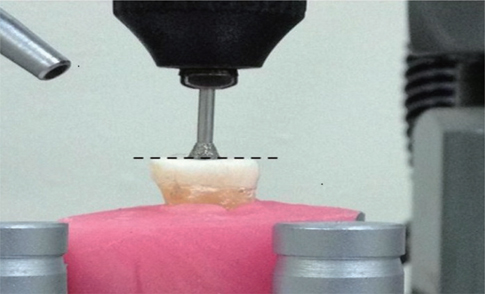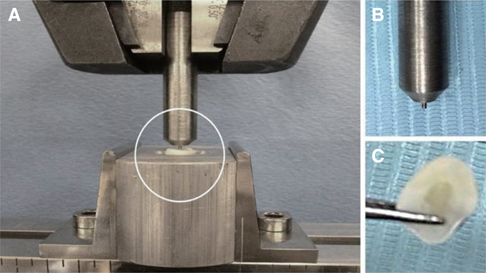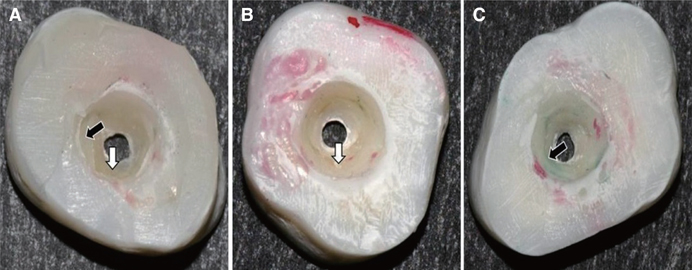J Adv Prosthodont.
2015 Dec;7(6):446-453. 10.4047/jap.2015.7.6.446.
Bonding values of two contemporary ceramic inlay materials to dentin following simulated aging
- Affiliations
-
- 1Department of Restorative Dental Sciences, College of Dentistry, King Khalid University, Abha, Saudi Arabia. bedie001@yahoo.com
- 2Department of Crown and Bridge, Faculty of Dentistry, Tanta University, Tanta, Egypt.
- KMID: 2176619
- DOI: http://doi.org/10.4047/jap.2015.7.6.446
Abstract
- PURPOSE
To compare the push-out bond strength of feldspar and zirconia-based ceramic inlays bonded to dentin with different resin cements following simulated aging.
MATERIALS AND METHODS
Occlusal cavities in 80 extracted molars were restored in 2 groups (n=40) with CAD/CAM feldspar (Vitablocs Trilux forte) (FP) and zirconia-based (Ceramill Zi) (ZR) ceramic inlays. The fabricated inlays were luted in 2 subgroups (n=20) with either etch-and-bond (RelyX Ultimate Clicker) (EB) or self-adhesive (RelyX Unicem Aplicap) (SA) resin cement. Ten inlays in each subgroup were subjected to 3,500 thermal cycles and 24,000 loading cycles, while the other 10 served as control. Horizontal 3 mm thick specimens were cut out of the restored teeth for push out bond strength testing. Bond strength data were statistically analyzed using 1-way ANOVA and Tukey's comparisons at alpha=.05. The mode of ceramic-cement-dentin bond failure for each specimen was also assessed.
RESULTS
No statistically significant differences were noticed between FP and ZR bond strength to dentin in all subgroups (ANOVA, P=.05113). No differences were noticed between EB and SA (Tukey's, P>.05) bonded to either type of ceramics. Both adhesive and mixed modes of bond failure were dominant for non-aged inlays. Simulated aging had no significant effect on bond strength values (Tukey's, P>.05) of all ceramic-cement combinations although the adhesive mode of bond failure became more common (60-80%) in aged inlays.
CONCLUSION
The suggested cement-ceramic combinations offer comparable bonding performance to dentin substrate either before or after simulated aging that seems to have no adverse effect on the achieved bond.
Keyword
MeSH Terms
Figure
Reference
-
1. Banks RG. Conservative posterior ceramic restorations: a literature review. J Prosthet Dent. 1990; 63:619–626.2. Hopp CD, Land MF. Considerations for ceramic inlays in posterior teeth: a review. Clin Cosmet Investig Dent. 2013; 5:21–32.3. Kawai K, Hayashi M, Torii M, Tsuchitani Y. Marginal adaptability and fit of ceramic milled inlays. J Am Dent Assoc. 1995; 126:1414–1419.4. Krejci I, Lutz F, Reimer M. Marginal adaptation and fit of adhesive ceramic inlays. J Dent. 1993; 21:39–46.5. Thordrup M, Isidor F, Hörsted-Bindslev P. Comparison of marginal fit and microleakage of ceramic and composite inlays: an in vitro study. J Dent. 1994; 22:147–153.6. Dietschi D, Maeder M, Meyer JM, Holz J. In vitro resistance to fracture of porcelain inlays bonded to tooth. Quintessence Int. 1990; 21:823–831.7. Leinfelder KF. Porcelain esthetics for the 21st century. J Am Dent Assoc. 2000; 131:47S–51S.8. Tyas MJ. Dental amalgam-what are the alternatives? Int Dent J. 1994; 44:303–308.9. Beier US, Kapferer I, Dumfahrt H. Clinical long-term evaluation and failure characteristics of 1,335 all-ceramic restorations. Int J Prosthodont. 2012; 25:70–78.10. Critchlow S. Ceramic materials have similar short term survival rates to other materials on posterior teeth. Evid Based Dent. 2012; 13:49.11. Molin M, Karlsson S. The fit of gold inlays and three ceramic inlay systems. A clinical and in vitro study. Acta Odontol Scand. 1993; 51:201–206.12. Martin N, Jedynakiewicz NM. Interface dimensions of CEREC-2 MOD inlays. Dent Mater. 2000; 16:68–74.13. Nathanson D. Etched porcelain restorations for improved esthetics, part II: Onlays. Compendium. 1987; 8:105–110.14. Jensen ME, Sheth JJ, Tolliver D. Etched-porcelain resinbonded full-veneer crowns: in vitro fracture resistance. Compendium. 1989; 10:336–338. 340–341. 344–347.15. Dietschi D, Maeder M, Meyer JM, Holz J. In vitro resistance to fracture of porcelain inlays bonded to tooth. Quintessence Int. 1990; 21:823–831.16. Llobell A, Nicholls JI, Kois JC, Daly CH. Fatigue life of porcelain repair systems. Int J Prosthodont. 1992; 5:205–213.17. Abdelaziz KM, Al-Qahtani NM, Al-Shehri AS, Abdelmoneam AM. Bonding quality of contemporary dental cements to sandblasted esthetic crown copings. J Investig Clin Dent. 2012; 3:142–147.18. Frankenberger R, Lohbauer U, Schaible RB, Nikolaenko SA, Naumann M. Luting of ceramic inlays in vitro: marginal quality of self-etch and etch-and-rinse adhesives versus self-etch cements. Dent Mater. 2008; 24:185–191.19. Taschner M, Krämer N, Lohbauer U, Pelka M, Breschi L, Petschelt A, Frankenberger R. Leucite-reinforced glass ceramic inlays luted with self-adhesive resin cement: a 2-year in vivo study. Dent Mater. 2012; 28:535–540.20. Santos MJ, Mondelli RF, Navarro MF, Francischone CE, Rubo JH, Santos GC Jr. Clinical evaluation of ceramic inlays and onlays fabricated with two systems: five-year follow-up. Oper Dent. 2013; 38:3–11.21. Frankenberger R, Taschner M, Garcia-Godoy F, Petschelt A, Krämer N. Leucite-reinforced glass ceramic inlays and onlays after 12 years. J Adhes Dent. 2008; 10:393–398.22. Sjgren G, Molin M, van Dijken JW. A 10-year prospective evaluation of CAD/CAM-manufactured (Cerec) ceramic inlays cemented with a chemically cured or dual-cured resin composite. Int J Prosthodont. 2004; 17:241–246.23. Krämer N, Frankenberger R. Clinical performance of bonded leucite-reinforced glass ceramic inlays and onlays after eight years. Dent Mater. 2005; 21:262–271.24. Guarda GB, Correr AB, Gonçalves LS, Costa AR, Borges GA, Sinhoreti MA, Correr-Sobrinho L. Effects of surface treatments, thermocycling, and cyclic loading on the bond strength of a resin cement bonded to a lithium disilicate glass ceramic. Oper Dent. 2013; 38:208–217.25. Zorzin J, Belli R, Wagner A, Petschelt A, Lohbauer U. Self-adhesive resin cements: adhesive performance to indirect restorative ceramics. J Adhes Dent. 2014; 16:541–546.26. Stawarczyk B, Ozcan M, Hallmann L, Ender A, Mehl A, Hämmerlet CH. The effect of zirconia sintering temperature on flexural strength, grain size, and contrast ratio. Clin Oral Investig. 2013; 17:269–274.27. Flury S, Lussi A, Peutzfeldt A, Zimmerli B. Push-out bond strength of CAD/CAM-ceramic luted to dentin with self-adhesive resin cements. Dent Mater. 2010; 26:855–863.28. Heintze SD, Faouzi M, Rousson V, Ozcan M. Correlation of wear in vivo and six laboratory wear methods. Dent Mater. 2012; 28:961–973.29. Subramanian D, Sivagami G, Sendhilnathan D, Rajmohan C. Effect of thermocycling on the flexural strength of porcelain laminate veneers. J Conserv Dent. 2008; 11:144–149.30. Hashem AA, Ghoneim AG, Lutfy RA, Fouda MY. The effect of different irrigating solutions on bond strength of two root canal-filling systems. J Endod. 2009; 35:537–540.31. Martin N, Jedynakiewicz NM. Clinical performance of CEREC ceramic inlays: a systematic review. Dent Mater. 1999; 15:54–61.32. Dietschi D, Maeder M, Meyer JM, Holz J. In vitro resistance to fracture of porcelain inlays bonded to tooth. Quintessence Int. 1990; 21:823–831.33. Soares CJ, Santana FR, Castro CG, Santos-Filho PC, Soares PV, Qian F, Armstrong SR. Finite element analysis and bond strength of a glass post to intraradicular dentin: comparison between microtensile and push-out tests. Dent Mater. 2008; 24:1405–1411.34. Cheylan JM, Gonthier S, Degrange M. In vitro push-out strength of seven luting agents to dentin. Int J Prosthodont. 2002; 15:365–370.35. Queiroz JR, Souza RO, Nogueira Junior L Jr, Ozcan M, Bottino MA. Influence of acid-etching and ceramic primers on the repair of a glass ceramic. Gen Dent. 2012; 60:e79–e85.36. Souza RO, Castilho AA, Fernandes VV, Bottino MA, Valandro LF. Durability of microtensile bond to nonetched and etched feldspar ceramic: self-adhesive resin cements vs conventional resin. J Adhes Dent. 2011; 13:155–162.37. Valandro LF, Ozcan M, Bottino MC, Bottino MA, Scotti R, Bona AD. Bond strength of a resin cement to high-alumina and zirconia-reinforced ceramics: the effect of surface conditioning. J Adhes Dent. 2006; 8:175–181.38. Viotti RG, Kasaz A, Pena CE, Alexandre RS, Arrais CA, Reis AF. Microtensile bond strength of new self-adhesive luting agents and conventional multistep systems. J Prosthet Dent. 2009; 102:306–312.39. Feitosa SA, Corazza PH, Cesar PF, Bottino MA, Valandro LF. Pressable feldspathic inlays in premolars: effect of cementation strategy and mechanical cycling on the adhesive bond between dentin and restoration. J Adhes Dent. 2014; 16:147–154.40. Kious AR, Roberts HW, Brackett WW. Film thicknesses of recently introduced luting cements. J Prosthet Dent. 2009; 101:189–192.41. Amaral R, Ozcan M, Valandro LF, Balducci I, Bottino MA. Effect of conditioning methods on the microtensile bond strength of phosphate monomer-based cement on zirconia ceramic in dry and aged conditions. J Biomed Mater Res B Appl Biomater. 2008; 85:1–9.42. Wegner SM, Gerdes W, Kern M. Effect of different artificial aging conditions on ceramic-composite bond strength. Int J Prosthodont. 2002; 15:267–272.43. Vanderlei A, Passos SP, Özcan M, Bottino MA, Valandro LF. Durability of adhesion between feldspathic ceramic and resin cements: effect of adhesive resin, polymerization mode of resin cement, and aging. J Prosthodont. 2013; 22:196–202.44. Osorio R, Castillo-de Oyagüe R, Monticelli F, Osorio E, Toledano M. Resistance to bond degradation between dualcure resin cements and pre-treated sintered CAD-CAM dental ceramics. Med Oral Patol Oral Cir Bucal. 2012; 17:e669–e677.45. Kumbuloglu O, Lassila LV, User A, Vallittu PK. Bonding of resin composite luting cements to zirconium oxide by two air-particle abrasion methods. Oper Dent. 2006; 31:248–255.46. Tanaka R, Fujishima A, Shibata Y, Manabe A, Miyazaki T. Cooperation of phosphate monomer and silica modification on zirconia. J Dent Res. 2008; 87:666–670.47. Gomes AL, Ramos JC, Santos-del Riego S, Montero J, Albaladejo A. Thermocycling effect on microshear bond strength to zirconia ceramic using Er:YAG and tribochemical silica coating as surface conditioning. Lasers Med Sci. 2015; 30:787–795.48. Flury S, Lussi A, Peutzfeldt A, Zimmerli B. Push-out bond strength of CAD/CAM-ceramic luted to dentin with self-adhesive resin cements. Dent Mater. 2010; 26:855–863.49. Aleisa KI, Almufleh BS, Morgano SM, Lynch CD. Effect of types of luting agent on push-out bond strength of zirconium oxide posts. J Dent. 2013; 41:377–383.50. Saavedra G, Ariki EK, Federico CD, Galhano G, Zamboni S, Baldissara P, Valandro LF. Effect of acid neutralization and mechanical cycling on the microtensile bond strength of glass-ceramic inlays. Oper Dent. 2009; 34:211–216.
- Full Text Links
- Actions
-
Cited
- CITED
-
- Close
- Share
- Similar articles
-
- Microleakage of dentin bonding agents in porcelain laminate veneer under simulated physiologic pressure
- THE EFFECT OF SURFACE TREATMENT ON FRACTURE STRENGTH OF DENTAL CERAMICS
- Microtensile bond strength of resin inlay bonded to dentin treated with various temporary filling materials
- Micro-shear bond strength to dentin under simulated pulpal pressure
- Shear bond strength of the three different kinds of resin cement on CAD/CAM ceramic inlay





